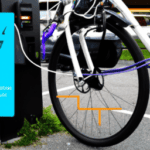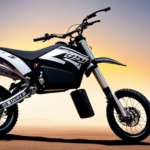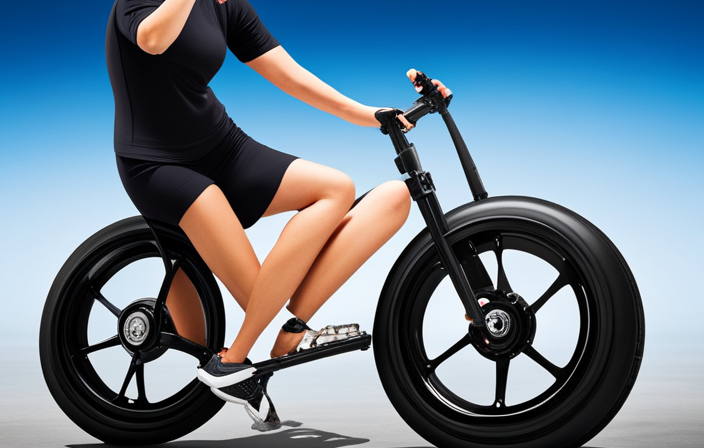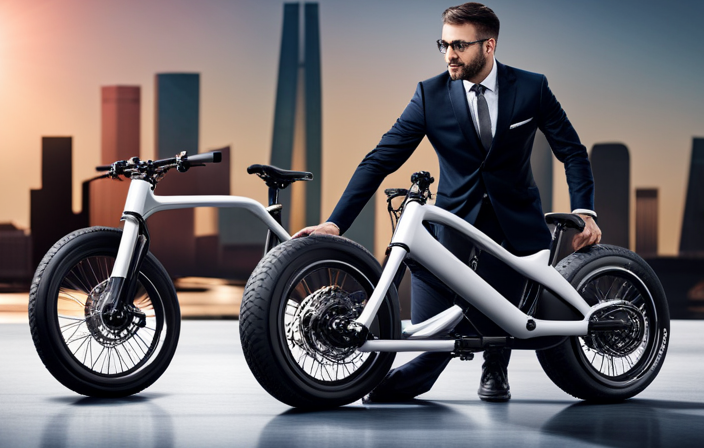How do you recharge an electric bike?
As an electric bike enthusiast, I understand the importance of keeping your bike’s battery charged for optimal performance. In this article, I will guide you through the process of recharging your electric bike, sharing expert tips and tricks along the way.
From understanding your bike’s battery to finding the right charging method and practicing proper charging habits, I’ll cover it all.
So, let’s dive in and ensure your electric bike is always ready for your next adventure!
Key Takeaways
- Fully charge the battery to ensure optimal performance and longevity.
- Avoid letting the battery completely discharge to prevent cell damage.
- Maintain moderate temperature for the battery to function at its best.
- Prevent overcharging the battery to avoid reduced capacity over time.
Understand Your Electric Bike’s Battery
To recharge your electric bike, you’ll need to understand how its battery works. Understanding battery capacity is crucial in determining the range and duration of your rides. Battery capacity is measured in watt-hours (Wh), which indicates the amount of energy the battery can store.
Monitoring battery performance is also essential to ensure optimal charging. Keep an eye on the battery level indicator on your bike’s display or use a battery monitoring app for more accurate readings. It’s important to note that battery performance can be affected by factors like temperature and terrain.
Now that you understand your electric bike’s battery, let’s move on to the next section and learn about choosing the right charging method.
Choose the Right Charging Method
Selecting the appropriate charging method is crucial when recharging an e-bike. To maximize battery efficiency, it is essential to explore alternative charging options.
One option is to use a standard wall outlet, which is suitable for most e-bike batteries. However, this method usually takes longer to fully charge the battery.
Another option is a fast charger, which can significantly reduce charging time but may impact the battery’s lifespan. It is important to check the manufacturer’s recommendations before using a fast charger.
Additionally, some e-bikes offer the option of removable batteries, allowing you to charge the battery separately from the bike. This can be convenient if you don’t have access to a charging station nearby.
Finding a convenient charging station is the next step in ensuring your e-bike is always ready for your next adventure.
Find a Convenient Charging Station
Finding a nearby charging station is essential for ensuring your e-bike is always ready for your next ride. To find charging options, you can use various resources like mobile apps, websites, or even ask fellow e-bike enthusiasts for recommendations. Once you locate a convenient charging station, it’s important to consider its reliability, accessibility, and charging speed. Reliability ensures that the station is functional and won’t leave you stranded. Accessibility refers to the ease of reaching the station and whether it’s compatible with your bike’s charging port. Lastly, charging speed determines how quickly your e-bike can recharge. By finding a charging station that meets these criteria, you can save energy and maximize your riding time. Now, let’s move on to the next section where we will discuss how to follow proper charging practices.
Follow Proper Charging Practices
When it comes to charging my electric bike, I always follow proper charging practices to ensure the longevity and efficiency of my battery.
First and foremost, I make sure to avoid overcharging by monitoring the charging process and disconnecting the charger once the battery is fully charged.
Additionally, I charge my bike at the right time, usually during off-peak hours, to take advantage of lower electricity rates and reduce strain on the grid.
Lastly, I store my battery properly by keeping it in a cool and dry place, away from extreme temperatures and direct sunlight, to prevent any damage or degradation.
By adhering to these practices, I can maximize the lifespan and performance of my electric bike’s battery.
Avoid Overcharging
To avoid overcharging your electric bike, make sure you don’t leave it plugged in for too long. Overcharging can lead to reduced battery life and performance.
It is crucial to follow proper charging practices to maintain the health of your electric bike’s battery. When you plug in your bike for charging, keep an eye on the charging time and disconnect it once it reaches 100% capacity. Leaving it plugged in for an extended period can cause the battery to heat up, leading to potential damage.
Additionally, it is advisable to charge your electric bike in a cool and well-ventilated area to prevent overheating. By avoiding overcharging and practicing proper battery maintenance, you can ensure a longer lifespan for your electric bike’s battery.
Now, let’s move on to the next section about charging at the right time.
Charge at the Right Time
Make sure to charge your bike at the optimal time to maximize its battery life and performance. Charging overnight or during off-peak hours is the best way to ensure efficient recharging. Here are four reasons why:
-
Cost savings: Charging during off-peak hours often comes with lower electricity rates, helping you save money in the long run.
-
Grid stability: Charging during off-peak hours reduces the strain on the power grid, contributing to a more stable and reliable electricity supply.
-
Battery longevity: Charging overnight allows the battery to go through a complete charge cycle, which helps maintain its overall health and extend its lifespan.
-
Convenience: Charging at night means your bike will be ready to go in the morning, ensuring a seamless and hassle-free riding experience.
By following these guidelines, you can optimize your electric bike’s battery performance and lifespan.
Now let’s discuss how to properly store your battery.
Store Your Battery Properly
Storing your battery properly is essential for maintaining its performance and longevity. Proper storage techniques can help prevent unnecessary wear and tear on your electric bike battery, ensuring that it remains in optimal condition for a longer period of time. Here are a few key points to keep in mind when it comes to storing your battery:
| 1. | Store in a cool, dry place | 2. | Keep away from extreme temperatures |
| 3. | Avoid storing in direct sunlight | 4. | Store at around 50% charge |
By following these guidelines, you can prolong the lifespan of your battery and maintain its overall health. Proper storage practices are just one aspect of battery maintenance. To further ensure your battery’s performance, it is important to regularly monitor its health and take necessary steps to optimize its usage.
Monitor Your Battery’s Health
Check your battery’s health regularly to ensure optimal performance of your electric bike. Monitoring battery usage is key to extending battery life and maximizing your riding experience. Here are five important factors to consider:
- Keep an eye on the battery’s voltage levels to avoid overcharging or discharging.
- Use a battery health app or monitor to track the battery’s capacity and detect any potential issues.
- Avoid exposing the battery to extreme temperatures, as it can negatively impact its performance.
- Regularly clean the battery terminals to maintain a good connection and prevent corrosion.
- Follow the manufacturer’s guidelines for charging and discharging cycles to prolong the battery’s lifespan.
By monitoring your battery’s health, you can ensure that it functions optimally and lasts longer.
Now, let’s delve into how to optimize your riding style for battery life.
Optimize Your Riding Style for Battery Life
To maximize your battery life, it’s important to adjust your riding style accordingly. Riding techniques can significantly impact the lifespan of your electric bike’s battery.
One key tip is to avoid excessive acceleration and deceleration, as this puts a strain on the battery. Instead, try to maintain a steady speed and use the bike’s gears efficiently.
Another battery-saving tip is to pedal along with the electric motor, especially when starting from a stop or going uphill. This reduces the workload on the battery and extends its life.
Additionally, avoid riding at maximum power for prolonged periods and consider using lower power levels when possible.
By adopting these riding techniques, you can optimize your battery’s performance and prolong its lifespan.
To further enhance your riding experience, consider investing in a spare battery for longer rides or emergencies. This ensures you always have a backup power source available.
Consider Investing in a Spare Battery
Consider investing in an extra battery for increased convenience and extended riding range. Investing in spare parts is a smart move for any electric bike owner, as it ensures that you always have a backup when needed. By having a spare battery on hand, you can easily swap them out when one runs out of power, allowing you to continue riding without interruption. It is important to note that proper battery maintenance is crucial for optimal performance and longevity. To maximize the lifespan of your batteries, make sure to follow these battery maintenance tips: regularly charge and discharge the battery, store it in a cool and dry place, and avoid overcharging. Taking these precautions will help extend the lifespan of your batteries and keep them performing at their best. Now, let’s move on to the next section and explore how to take advantage of regenerative braking.
Take Advantage of Regenerative Braking
Using regenerative braking on your e-bike can help you maximize efficiency and extend the battery life. This feature allows the motor to act as a generator and convert kinetic energy into electrical energy, which is then stored in the battery.
When you apply the brakes, the motor slows down the bike and simultaneously generates electricity. This energy is then fed back into the battery, replenishing its charge.
By taking advantage of regenerative braking, you can recharge your electric bike while riding, reducing the need to rely solely on external charging sources. This not only increases the range of your bike but also saves you time and money.
Now, let’s explore energy-saving features on your electric bike to further enhance your riding experience and extend battery life.
Explore Energy-Saving Features on Your Electric Bike
When it comes to maximizing the energy efficiency of my electric bike, I always make sure to take advantage of the various energy-saving features available.
The first key point is to use the Eco Mode, which optimizes power consumption by limiting the motor’s output and reducing overall energy usage.
Additionally, adjusting power levels allows me to customize the amount of assistance provided by the motor, conserving energy when I don’t need as much help.
Lastly, utilizing energy recovery systems such as regenerative braking allows me to recharge the bike’s battery while riding, further increasing the overall energy efficiency.
Use Eco Mode
To conserve battery power, simply switch to Eco Mode on your electric bike. Eco Mode is a great feature that allows you to maximize your bike’s efficiency and extend your battery life.
When you activate Eco Mode, the bike’s power output is reduced, which means it uses less energy to propel you forward. This can result in a significant increase in your bike’s range, allowing you to travel longer distances without needing to recharge.
However, there are a few disadvantages to using Eco Mode. The reduced power output can make it harder to tackle steep hills or ride at high speeds. Additionally, the acceleration may be slower compared to other modes.
Nonetheless, adjusting power levels is an essential aspect of optimizing your electric bike’s performance. By finding the right balance between power and efficiency, you can ensure a smooth and enjoyable ride.
Adjust Power Levels
Adjusting power levels on your e-bike can enhance performance and optimize efficiency. By adjusting the power levels, you can customize the amount of assistance the electric motor provides while pedaling. This allows you to find the perfect balance between exertion and assistance, ensuring a smooth and enjoyable ride. Troubleshooting power issues becomes easier when you have the ability to adjust power levels. It allows you to identify and resolve any problems that may arise, such as insufficient battery power or motor malfunctions. To help you understand the impact of adjusting power levels, consider the following table:
| Power Level | Motor Assistance (%) |
|---|---|
| Low | 50% |
| Medium | 75% |
| High | 100% |
| Off | 0% |
| Turbo | 125% |
By adjusting the power levels, you can fine-tune your e-bike’s performance to suit your needs. This customization is an important aspect of utilizing energy recovery systems effectively and efficiently.
Utilize Energy Recovery Systems
Utilizing energy recovery systems on your e-bike can help maximize efficiency and extend battery life. These systems, such as regenerative braking, allow you to harness and store energy that would otherwise be wasted.
Here are three key benefits of incorporating energy recovery systems into your electric bike:
-
Increased Range: By capturing and storing energy during braking or coasting, regenerative braking systems can provide a boost to your e-bike’s range. This means you can go further on a single charge without depleting your battery.
-
Extended Battery Life: Energy recovery systems help reduce the strain on your battery by utilizing the energy that would otherwise be lost. By minimizing the amount of energy drawn from the battery, these systems can help prolong its lifespan.
-
Enhanced Efficiency: By converting kinetic energy into electrical energy, energy recovery systems make your e-bike more efficient. This means you can get more out of each pedal stroke and enjoy a smoother, more responsive ride.
Utilizing energy recovery systems on your e-bike not only benefits the environment but also enhances your overall riding experience. Enjoy your rides and keep your battery charged!
Enjoy Your Rides and Keep Your Battery Charged!
Make sure you fully charge your electric bike battery before heading out for a ride.
Understanding battery capacity is crucial to maximizing your bike’s performance. It’s important to know the specific capacity of your battery to determine how far you can ride before needing to recharge.
To extend battery life, there are a few key practices to keep in mind.
Firstly, avoid letting your battery completely discharge as this can damage its cells.
Secondly, try to keep your battery at a moderate temperature, as extreme heat or cold can negatively affect its performance.
Lastly, avoid overcharging your battery, as this can lead to reduced capacity over time.
By following these tips, you can enjoy your rides and ensure your battery lasts longer.
Frequently Asked Questions
Can I charge my electric bike using a regular power outlet at home?
Yes, you can charge your electric bike using a regular power outlet at home. However, using a dedicated charger provides faster charging times and protects the battery life, making it the preferred option.
How long does it typically take to fully charge an electric bike battery?
Charging an electric bike battery typically takes around 4-6 hours, but this can vary depending on factors like battery capacity, charger output, and initial battery charge level. So, it’s important to consider these factors when estimating charging time.
Is it safe to charge my electric bike battery overnight?
Charging precautions are essential when it comes to electric bike batteries. It is not recommended to charge them overnight due to the risk of overcharging and potential damage. Consider alternative charging methods to ensure a safe and efficient battery recharge.
Can I use a fast-charging station to charge my electric bike battery?
Yes, you can use a fast-charging station to recharge your electric bike battery. Fast charging offers the benefit of shorter charging times, but alternative charging options, such as using a regular power outlet, are also available.
Are there any specific tips to extend the lifespan of my electric bike battery?
To maximize the range of your electric bike battery, follow these tips: maintain proper tire pressure, avoid excessive acceleration and braking, and use pedal assist wisely. Also, store your battery in a cool, dry place during periods of non use.
Conclusion
In conclusion, recharging an electric bike is a crucial aspect of owning one. By understanding your bike’s battery and following proper charging practices, you can ensure its longevity and optimal performance.
Did you know that on average, an electric bike battery can last up to 4 years or around 1000 charge cycles? That’s like riding from coast to coast 13 times!
So, make sure to take care of your battery and enjoy the endless rides it can provide. Keep pedaling and keep recharging!
















